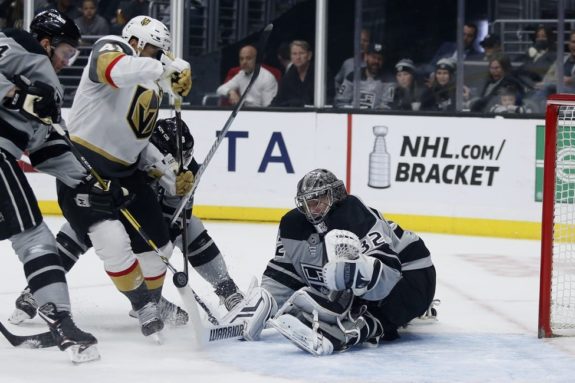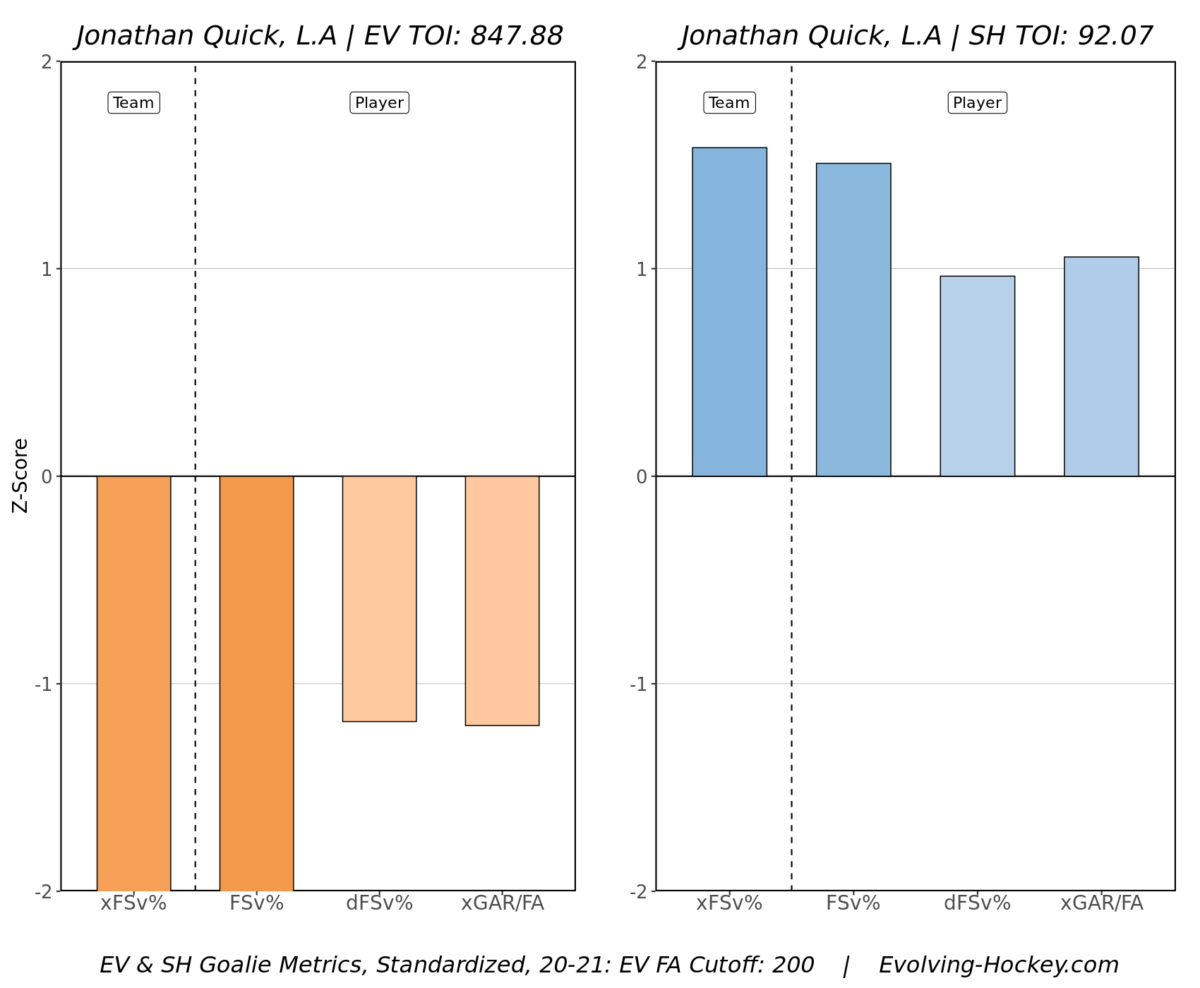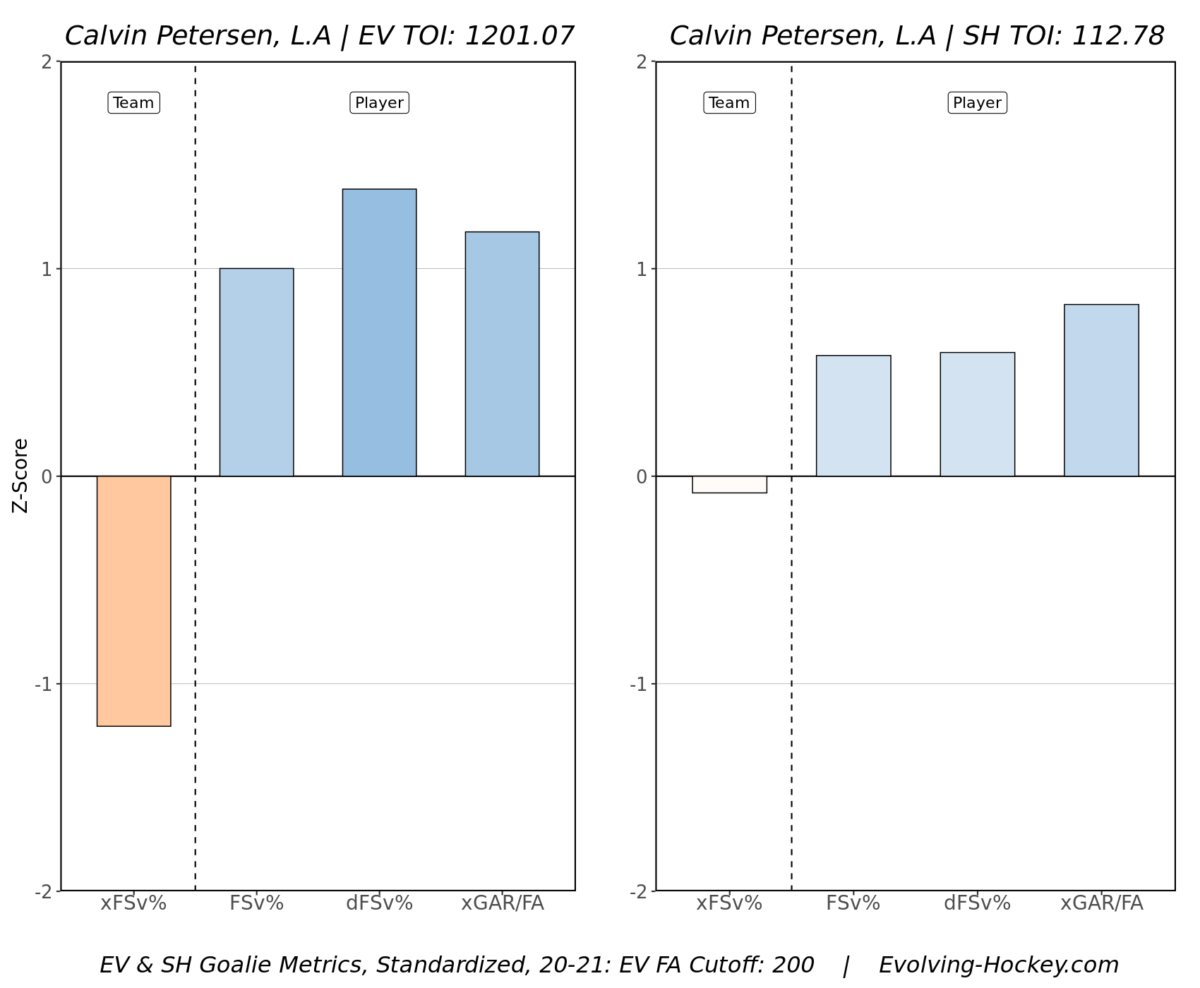The Los Angeles Kings have been one of the league’s best teams over the last decade. The franchise made the playoffs six times in the 10 seasons, capturing two Stanley Cups, one in 2012 and one in 2014. It is near-impossible for any NHL team to have that kind of sustained success without stellar goaltending. The last decade of team’s goaltending has belonged to Jonathan Quick.
Quick played his best season in 2011-12, putting up an astounding .929 save percentage (SV%) and a 1.95 goals-against average (GAA), both career-high totals. Though not all of his campaigns resembled that of 2011-12, he has been a consistently good goaltender for the Kings throughout his lengthy career.
The now 35-year-old has seen a drop-off over the last few seasons, though. The good news for the Kings is that they have the up-and-coming Calvin Petersen ready to take over. He has silenced the doubters this season, proving he is the real deal. All the team needs to do is commit to him and give him the net he has earned.
Quick’s Downfall
Unlike most older goaltenders, Quick’s downfall was a sudden one. Rather than slowly going from an elite goaltender to putting up numbers that would warrant a backup role, he saw a very abrupt drop in play. This decline coincided with that of the team as a whole.

The Kings finished the 2017-18 season with a record of 45-29-8, fourth in the division. That would be the last respectable season for the team before entering the rebuild, and the same was true for Quick. He posted a .921 SV% and a 2.40 GAA, also showing a very impressive 27.49 goals saved above expected (GSAx), second in the league that season.
The 2018-19 season was a very different story for both the Kings and Quick. LA finished the season with a record of 31-42-9, last in the Pacific Division. Quick saw a full-season career-worst .888 SV% and 3.38 GAA. This was quite the turnaround considering he was one of the best goalies in the league just a season prior. Though he rebounded in the following season, he never returned to the Quick of the playoff runs from the early 2010s.
Petersen’s Rise
Petersen was originally drafted by the Buffalo Sabres in the fifth round of the 2013 draft, 129th overall. Prior to becoming a pro, he played for the University of Notre Dame for three seasons. He posted consistent numbers over his college career, earning him a contract with the Kings.

Petersen played the 2017-18 season exclusively with the Ontario Reign of the AHL where he continued to put up good numbers. Dissimilar to Quick, Petersen’s rise went along with the fall of the Kings. He played his first NHL games in the 2018-19 season, putting up more impressive statistics. He showed a .924 SV%, 10th in the league, and a 2.61 GAA, albeit only playing 11 games. Petersen went on to play another NHL season, but again only produced a small sample size. After eight games, he showed a .922 SV% and a 2.64 GAA.
Throughout his college and pro career, Petersen has always been a consistent goaltender. Coming into the 2020-21 season, many doubted him simply due to the number of games he had played in the NHL at the time, but so far he has proved he is legit.
Comparing Quick and Petersen This Season
Quick is having yet another poor season, nearly matching his career-worst campaign from 2018-19. He has posted a .890 SV% and a 3.06 GAA. He has also shown a -6.11 GSAx, which isn’t horrible when comparing him to some of the goaltenders at the bottom of the league, but he is not stopping all of the pucks he is expected to. He has also been making some uncharacteristic mistakes, such as allowing this goal versus the Vegas Golden Knights.
On the goal, the puck does bounce, but it doesn’t drastically change direction. The puck simply went through Quick on the misplay. Plays like this one show how he is losing his touch as he continues to get older, contributing to his negative GSAx.
Petersen, on the other hand, has had a great season in net for the Kings. He has posted a .920 SV%, along with a 2.67 GAA. His most impressive statistic, though, is his GSAx. He has posted a 9.4 GSAx so far this season, seventh in the league, 6th for goaltenders playing more than 10 games.
Another important aspect of Petersen’s game is how he plays against the division’s best teams. He has put up a .925 SV% and a 2.01 GAA versus the St. Louis Blues, a .928 SV% and a 2.81 GAA versus the Golden Knights, and a very impressive .936 SV% and a 2.37 GAA versus one of the league’s highest-scoring teams, the Colorado Avalanche.
Purely based on the numbers, the discrepancies between Quick and Petersen are already clear. However, when comparing them visually through Evolving-Hockey’s goalie charts, the differences in their play this season become even more obvious.

Jonathan Quick 2020-21 Goalie Chart (Evolving-Hockey) 
Calvin Petersen 2020-21 Goalie Chart (Evolving-Hockey)
Despite how differently Quick and Petersen’s seasons have gone, they are still nearly splitting starts. While I think Quick should definitely get some playing time for the remainder of the season, the Kings should play Petersen more often. Playing Petersen improves the chance the team has at making the playoffs, and more experience will only improve his game.
Looking Forward
The 2020-21 season is nearly finished, and there are some big things for the Kings to take away from the run, especially when it comes to goaltending. As expected by many, this season has shown that Quick simply isn’t the player that he used to be, but Petersen is ready to take the reins. Next season, the team should award Petersen the starter role, and he should play almost as much as any goalie in the league: at least 70 percent of the games. This change in net will be a significant step towards finishing the rebuild and entering the next era of Kings hockey.
Advanced Stats per Evolving-Hockey